Archive for July, 2017
The Amazing World of Gumball Recaps: “The DVD” and “The Responsible”
Posted by kjohnson1585 in Animation, Television, The Amazing World of Gumball Recaps, Writing on July 31, 2017
I’ve been wanting to do episodic recaps for The Amazing World of Gumball for a while now. I’ve tried to convince a few of of the websites I freelance for to cover this show, but it never catches on. In the past year or two, the show has been gaining massive popularity – somewhat unfortunately, in the “I can’t believe they went there” fashion, but there are those who recognize it for its boldness, brilliance, cleverness, sharply dynamic animation, and flawed, enriching characters. Since mainstream critics won’t call attention to it (while frustrating, I do get it), I decided to tackle the show myself. I’m looking forward to it, especially as the show breaks from its original basic setup into a harsh, powerful, dramatic satire of a surprisingly put-together world.
The Amazing World of Gumball Season 1 Episode… by gumball-amazing
“The DVD” – B+
The Amazing World of Gumball will take some time to get to that point. It won’t push boundaries, or raise stakes, or truly commit to the honest, raw, and genuine emotional state of its central characters until some point in the second season. By that time the animation will have changed, and with that, a clearer observation of who and what the characters and the world of The Amazing World of Gumball can be. But we shouldn’t discount what occurs in “The DVD.” The basic, core characterizations are here: Gumball is the awkward kid who’s blindly committed to bad ideas, Darwin is the nice brother who cowtows to Gumball’s whims while simultaneously tries to talk him out of it, and Nicole, Gumball’s mother and the show’s early and continuous standout, is the stereotypical mother figure with a hilariously overbearing, militant streak. The show will complicate those attributes further overtime. But for now, “The DVD” is a basic fun lark, a taste of things to come.
One fascinating thing is that the characters feel fully realized, if not fully formed, in the early going. The opening exchange, that very first joke of escalating passive-aggressiveness between Gumball and his mother, immediately provides the early glimpses of the specifics of the characters, and even a sense of the type of show The Amazing World of Gumball will end up being. The final line, in which Gumball suggests that this entire issue with the DVD is Nicole’s fault for having kids in the first place (and before Nicole showcases her iconic, individual strength by punching through a wall), hints at a level of adult humor that the show will grow more and more comfortable in utilizing as the show goes on. I’ll need to make a point though – “getting away with adult jokes” is not at all what Gumball should be recognized for.
No, the juicier material lies within the entire scenario in which Gumball and his brother Darwin attempt to avoid “the consequences of their actions” and attempt to return a fake DVD and ensure their mom never learns about it. It’s cartoony basics here, with jokes like a fake cardboard DVD, Darwin speaking a long line in Chinese that’s translated as a simple “No,” and an amusing scene in which Gumball finds himself deeply allergic to makeup. Yet Gumball will also get a bit harsher with its satire, like the scene in which the two lower-middle class brothers beg on the street next to an an actual homeless man. It’s a dark, pointed gag, in which the homeless man not so subtly points out the insanity of the situation. It’s also pretty fucked up that the implication is that Gumball and Darwin received more change than the person who actually needed it (symbolized by a ridiculous beatboxing scene, where the two siblings once again get change over the homeless man). Karma comes quickly once the man takes the change buys a scratch-off, and wins; when Gumball then asks for his four dollars back, the formerly-homeless man feigns no longer having any change on him. It’s brutal, especially once it becomes clearer that the Wattersons aren’t quite wealthy in their own specific ways, and Gumball will get incredibly more direct on this point later in the series.
The ending sequence is also a perfect taste of what Gumball will improve upon as the show goes on as well – an epic chase scene in which Nicole runs – and I mean runs – after her children in anger from the lies. Even this early in the animation, it’s a visual masterpiece, with an action-movie sensibility to the aesthetics, and props to making it clear that Nicole’s rage, while epic, can be on occasion hindered. It ends on a couple of generic but hilarious gags and tropes – Larry watches the DVD and sees a terrible Sweded version of Alligators on a Train, Nicole hears the confession and declares her love for them is universal, and she pays the $25 fee for the DVD. But then the Gumball goes for what will mostly be its signature move, the ironic ending, the narrative switch that will keep viewers on its toes: when the late fees add up to a whopping $700, Nicole, nice, calm, and loving, tell her children to RUN. It’s perfect, a symbolic freeze-frame shot that sums up the show in a nutshell.
“The Responsible” – B
“The Responsible” introduces Richard Watterson and Anais Watterson. Both characters will go through some changes and deepening over the course of the show, particularly Richard, who will take a quite a while to make into a more workable character. Richard here is portrayed as the bumbling idiot, the comic relief who hates pants and whines like a manbaby. The Amazing World of Gumball as this point is still in its infant stages. It won’t really grasp its identity as a firm, (hyper)realistic, (dys)functional family until later. Right now, it’s mostly separate characters that are a family in name and gags only. Richard is a joke and Nicole is a machine, and Darwin and Gumball are the two who get into various scrapes. In this case, it’s how they take care of their baby sister, Anais, after Richard screws up in ordering a competent babysitter.
Anais is more solidified as a character. She will get even better, more or less contrasting her underrated genius and strategic thinking with her abject loneliness, youthful desperation, and the limits of her self-reliance. Here she has to struggle with her idiotic brothers as they go overboard with their protectiveness. She can’t watch TV (or specifically, commercials) because they’re corrupting, so she gets to witness Gumball and Darwin bash the TV set to death with bats. She can’t read a book, because she might get paper cuts, so Darwin jumpkicks it out of her hands. She can’t eat solid food (what her siblings pass as food anyway), so they chew it up and give her the chum. Rightfully, she knocks it back into their faces.
“The Responsible” is a fine, even visually great episode, with some great little details to keep your attention. It’s a great showcase, for example, when Darwin swims in the flooded house with ease, reminding you that he is indeed a fish (who enjoys his fishchips now and then). A steady shot in which Darwin and Gumball chase Anais around the living room is fantastic, mostly because it allows the space to be utilized in a lot of fun ways, sans cuts or edits. It doesn’t get a chance to get much deeper or exploratory though, mostly as an episode to enjoy the fruits of its animated labor. Its most cartoony moment is when they three pop out the chimney in a geyser and land hard on the sidewalk below, with only scratches. Yes, this is a cartoon, so this is a difficult line to walk, but while at this point The Amazing World of Gumball is more Looney Tunes, it’ll gradually pull away from that tone just enough so that stakes and threats will be harsher and more dangerous, eventually mastering it perfectly.
“The Responsible” also gets into Gumball’s narrative self-awareness, as this episode is all about the value and importance of responsibility (similar to “The DVD,” which is also why it’s a step down since it’s more or less a thematic retread). The lesson is learned, after a hellish experience, and the point is made when Gumball eventually accepts taking responsibility for the chaos… only to be unable to commit to it after staring into the flaming eyes of his mother. Gumball undercuts its lesson learning as every character ends up blaming something else for the disaster, eventually settling on the internet, which is part and parcel of the show’s ironic endings. But as the show goes along, that kind of undercutting will end up reaching some real, raw revelations that go being childish lesson learning, revelations that will be twice as significant as the basic ones. Claiming the internet is at fault is the show’s way of exploring the tendency of people to absolve themselves by pointing towards others who messed up (whataboutism), but The Amazing World of Gumball in time will provide much more bite to those kinds of endings. Which leaves this ending okay for what it is, especially this early in the show’s run, but once Gumball gets a firmer command on its voice, the perfect interplay with biting cynicism and genuine optimism, it’ll truly become one of television’s sharpest, most hilarious, most biting, and most effective programs.
Some Brief Words on Penn Zero: Part-Time Hero
Posted by kjohnson1585 in Animation, Television, Uncategorized, Writing on July 28, 2017
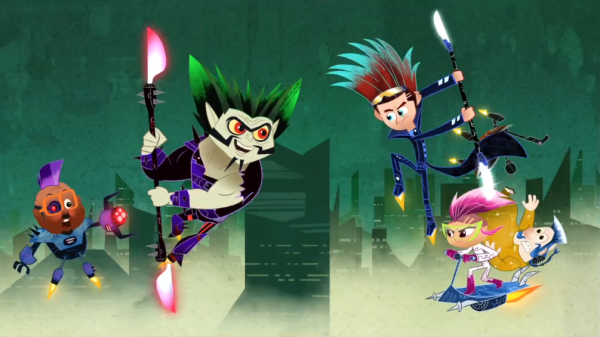
The premise of Penn Zero: Part-Time Hero doesn’t make any sense. A boy and his friends, who all still attend school, head into an abandoned theater where they are warped into alternate dimensions, take the role of some kind of protagonist/leader (and their sidekicks/lackeys), and have to accomplish some grand objective. When they do this, they (apparently?) take over the bodies of characters that already exist in that world. They also have to face a set of antagonists/villains that are controlled/taken over by their art teacher and school principal. When they return home, everything is back to the way things are – as normal as things could be. There’s a lot of questions. How did a bunch of kids get into the gig of interdimensional body-control and part-time heroics? (Penn, arguably, got into it through his parents – more on this later – but his sidekicks Sashi and Boone are occupational enigmas.) What happens to the people when they take over their bodies? What about Rippen and Larry? Who is Phyllis, the lady who controls the portal machine? What signals a particular world that needs heroics? Why would a world need competing villains? How long has all this been going on? And why?
I think that most of these questions were meant to be answered – or least explored – over the course of several seasons. It only received two. And as Penn Zero ends its two season run today, we’re given all the answers we’ll ever get (bearing an unlikely comic or graphic novel followup). In a way, it’s fine. The second season of Penn Zero did little about answering those big questions, and focused on smaller, personal bits of characterization – and exaggerated cartoon satire in the midst of broad, insanely creative alternate dimensions. The show scrambled together a brief, clearly-rushed season arc in which Penn had to find some crystal shards so Phyllis can track where his parents are (also part-time heroes), an arc that gets its due only in four of the final fourteen episodes. It spent most of its other episodes either revisiting past worlds with new, more intense objectives, or finding themselves in new locales with more ridiculous, almost nonsensical ones. Penn Zero, in its remaining season, culled together final episode pitches with an assortment of ideas that seem geared for a multiple seasons. It treated its second season as if it was its fifth season.
There’s something bold about that, though. I mean, if you’re forced to end your show a bit prematurely, you might as well throw all your best ideas out there. It may be too many ideas though. Episodes feel overrun at times, like Penn’s return to a world of dragons that, in the first season, just doubled as a Top Gun parody. The team’s second appearance incorporate elements from Star Wars, Aliens, My Little Pony, and a host of other pop culture references that I recognized. There’s also a lot of wink-winking towards animation tropes, like a hilarious anime-parody episode, a sitcom-bashing one, and one that engaged in a classic cat-and-mouse chase cartoon, similar to Tom & Jerry. Some episodes are just plan weird: the cast returns to a world where everyone is some kind of sport ball, literally, and it includes Curtis Armstrong as a super bouncy ball with serious insecurity and anger issues for some reason. An episode that checks in on Penn’s parents includes a fire-breathing giant chicken, a sketchy city inside the belly of said chicken, a sleazy pickpocket with an eyeball for a belly and lips for a head (voiced my Marc Maron), and mafioso, flamethrower-wielding grandmother with zombie cat demons for henchmen. This… is a weird show.
Speaking of which, the situation with Penn’s parents form the backbone of the show’s arc. They’re trapped in that bizarre world mentioned in the previous paragraph, and Penn has to recover three shards of… something to bring them back. It’s not exactly a tightly-scripted story arc – the retrieval of the first shard is accomplished during a weird random end tag, involving a giant Phyllis, which raises even more questions (and I know I’m skipping a lot of explanation here, but the episode has Penn deciding whether to go after the shard or save the day, and it doesn’t explain why Penn doesn’t just go after the shard after saving the day, or coming back to this world just a bit later). It does however delineate high-level stakes to these final episodes. There is pretty strong theme of loyalty, heroics, and sacrifice, especially between the roles of parental and childish figures, but fourteen episodes are not nearly enough to delve into them. Still, Penn Zero went ahead and did it anyway, which requires some balls.
You can’t help but wonder if Penn Zero: Part-Time Hero was meant to be the popular followup to Phineas and Ferb, another show that involved a weird-looking red-haired kid and random forays into strange places (that now looks to be Milo Murphy’s Law, a show that needs to explored at another time). Disney XD was going through some issues, and a lot of two season shows got shut down (including the delightful Wander Over Yonder and the not-so-delightful 7D). I don’t know if Penn Zero needed, or deserved, more time to flesh itself out. It was funny and clever enough, the characters were perfectly, comically realized (Sashi (Tani Guadi) was the overall show standout but second-season Penn (Thomas Middleditch) came up strong), and it clearly had a blast coming up with some of the alternate dimensions and the plots that took place in them. It felt like it got so caught up in that creative freeform that it never took the time it needed to really let its characters, and its specific in-world logic, explain itself.
That’s not necessarily bad. Lots of shows don’t make sense and thrive on that concept: Archer is purposely anachronistic, and Phineas and Ferb enjoyed its creative freedom. The latter show also knew to keep its central concept basic – a couple of kids just trying to find something to do during summer vacation – so when things did get crazy, it could count on cartoon logic to carry it through. Penn Zero often relies on cartoon logic as well – with plenty of self-aware, forth-wall gags, like when a Penn-as-kaiju destroys a “Rule of Thirds” Store on his third accidental stomp – but it’s too ingrained into its emotionally-charged backstory to escape from it. What happens if a hero fails – or worse, dies? That threat looms over the show, if never taken seriously whatsoever. Still, it’s possible, and I almost feel like the show would have been better off ditching any semblance of a season arc all together.
Still, Penn Zero: Part-Time Hero is just weird enough, funny enough, and creative enough to check out its final run, and its assortment of solid guest starts is also wildly impressive, which includes Mar Maron, Mark Hamill, Maria Bamford, Kumail Nanjiani, and Yvette Nicole Brown. Mercury Filmworks and Disney Television Animation pushes the paper-like-cutout designs in some striking ways within the animation, both large and small: large-scale, sweeping movements are as grandiose as some small, detailed facial expressions are hilarious. Penn Zero is a fun lark, and it’s somewhat sad to see it go “before its time,” but in some ways, it’s for the best. There’s too much going on that shouldn’t really be going on, and it’s better to end it before it reaches fan-theory status.
FINAL THOUGHTS ABOUT THE FINALE: If anything, “At the End of the Worlds” confirms the idea that Penn Zero: Part-Time Hero is probably better off ending now instead of continuing, even despite the fact it thrived with potential. It committed to a weirdness that felt more egregious than necessary or clever, and I’m not exactly talking about the revelation that Phil and Phyllis were separate entities of some kind of intergalactic time-space being gloriously entering Phase Two of some cosmic mission (I swear this is all true). You could argue, in a way, that the episode was parodying a lot of tropes of various grand finales: Boone sacrificing an “upgrade” for the sake of the team; a final fight with evil clones, with Sashi exploiting a weakness that she developed for years; an epic battle among the heroes and villains of the various worlds that Penn and Rippen visited in the past. It had an almost-at-peace death scene when Penn nearly falls to his death and reminisces about his parents. It had an almost-ironic parents-return-only-to-have-to-go-back-for-some-lame-reason (the show even lampshades its stupidity) moment. It had a “Rippen becomes good” sacrifice, only to be undercut by a bunch of random characters joining him. And then there’s the Phil/Phyllis thing, which played to the idea of needing a good/evil balance in the multiverse – although the show never really thematically supported that idea. It is… a lot, and I’ll always respect the hell out of the show just fucking doing all that, but I can’t exactly say we missed out on something grander. It is what it is, and kids will have their first(?) taste of something cerebral and mind-blowingly out-there. Beyond that? Nothing more revealing than a forced Penn/Sashi romantic pairing. So much for fan-theories.
Future-Worm May Co-opt Rick and Morty, but it Burrows Into Something Special and Unique
Posted by kjohnson1585 in Animation, Television, Uncategorized, Writing on July 25, 2017
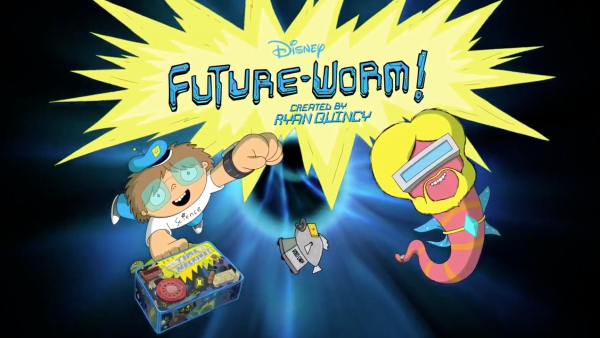
By the time you hear Justin Roiland’s voice pop up in the third episode of Future-Worm, entitled “Terrible Tuber Trouble,” you can breathe a sigh of relief. There was a sense that this show, based on the weird and stilted interstitials and bumpers that aired between Disney XD shows a few years ago, was a rip-off Rick and Morty, Adult Swim’s wildly entertaining hit show. The intros to both shows are tonally similar, and so is the color palette, but the nonchalant comical approach to surprisingly complex plotting is the real, obvious point of comparison. Both shows contain sarcastic, over-the-top, droll alien creatures, and even the father figure characters of both shows are sad-sack loser types. It smells like intellectual theft. But with Roiland’s squeaky, stammering vocals added to the mix, you at least get the sense that the co-creator of Rick and Morty is in on the heist.
Let’s back up a bit. Having low expectations for Future-Worm is understandable. It looks like one of the many secondary shows that attempt to thrive on attention and (young) viewership through weirdness. Such a style was born in the cultural misunderstandings of Spongebob and the genuine understandings of Adult Swim. From Pig, Goat, Banana, Cricket to Pickle and Peanut, to Teen Titans Go, kids networks’ have attempted to create their own “super-weird, super-funny” animated hit, mostly to no avail (except Teen Titans Go, which is still a hit but feels increasingly irrelevant). Future-Worm stars a boy named Danny, voiced by Andy Milonakis (who is in his 40s), who is friends with an anthropomorphic worm named Future (voiced by James Adomian). The show, despite its weird set up and design, has the two run off on adventures across time and space and dimensions, mostly on a whim. This sounds like a generic kid adventure story. Yet there’s an off-handed, devil-may-care approach to their adventuring: the two tend to chart off when bored, or callously looking for dumb answers to dumb questions, or wanting to escape from basic chores. And now the heightened mundane purpose of their travels feels somewhat stolen from Rick and Morty’s various shrugged-off travels.
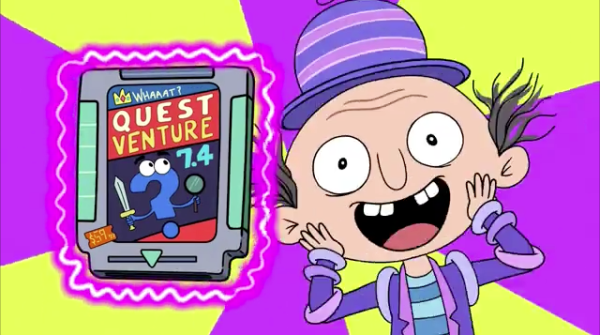
Well, if you’re going to steal, you might as well steal from the best, right? Rick and Morty is one of best shows ever, and with Roiland’s implicit approval of the show, Future-Worm is in good company. But even still, Ryan Quincy and his team manage to guide its influences and channel it through its own voice and direction, creating something that’s unique and weird, but also viciously clever – and viciously complex. From its interstitial beginnings, each episode of Future-Worm is divided into three parts, each of different lengths – twelve minutes, seven minutes, and three minutes. (The various lengths are familiar to animation fans: each type has been used before throughout animation history.) Disney probably mandated the lengths to shore up its burgeoning online/digital shorts package – the network most likely envisioned the show as simply-produced content to toss onto their Youtube channel or their Disney XD app (Disney feels like the only network that takes its online viewership seriously, as it now airs new episodes of shows online the same day those episodes are to be aired on television).
Quincy had something else in mind. Inspired by the post-credits tags in Rick and Morty, which play a comical, fast-and-loose response or commentary on the full episode itself, the Future-Worm team uses its unique structure to play around with the format and with the full marrative timeline of the show itself, while also using it a response or commentary to what came before it – or after it. It’s… difficult to describe, so it’s best to give examples. In the 12th episode, the first part ends with a weird gag in which an errant dimension-traveling device hits Danny’s parents in the head, transforming said heads into a car door and another head entirely. It seems like a random ending. But the second part tells the full adventure of what actually happened to the heads of Danny’s parents, which were transported to a “Death Race” in 3939. Or take the 11th episode: the second part tells a crazy story that Future-Danny (a figure separate from Danny himself) goes on, which involves people made of pliers trying to kill him. He escapes, fortunately, and the third part is Future-Danny trying to convince Bug, a friend of Danny, not to touch a certain pair of pliers, lest those same plier people track him down again. If that sounds confusing, it’s meant to be, but it’s also part of the value in rewatching episodes and tracking, even tangentially, the various timelines of what’s going on. Episodes connect in insanely temporal and atemporal ways, similar to Pulp Fiction’s nonlinear narrative; watch enough episodes, and it becomes clear that seemingly random segments are actually clues to its place within the “Future-Worm” timeline. Even then, the tone and energy of the show is so comedic and so devil-may-care (even the main characters don’t give a crap), that following along isn’t even that big of a deal (but valued if you do). There’s a whole semi-serious subplot involving lizard-people, powerful gems, and a prophesy, but Danny and Future-Worm can barely be bothered with it, even though it seems to be having some far reaching implications.
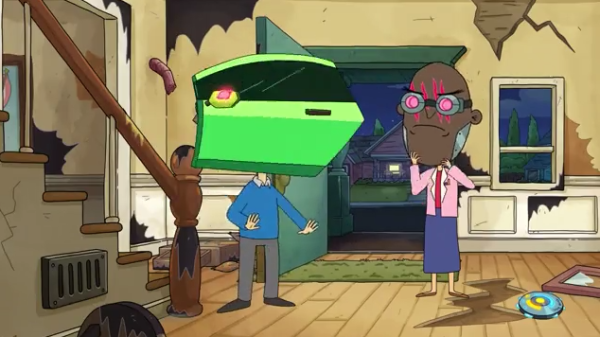
From part 1 of Episode 12, “Bug Vs. the Babysitter”
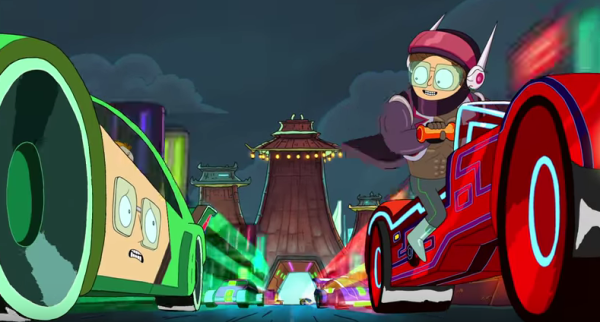
From part 2, Episode 12, “Doug Race: 3939”
Future-Worm is a complex, detailed, interlocking set of stories that combine into a slick, fully realized arc. Yet it also a silly, fun, episodic tale of two characters – a brilliant but lazy kid and a universe-travelled worm within a midlife crisis – who care little about that arc, and quite imply that viewers shouldn’t care either. Future-Worm is essentially a Croenburgean hybrid, a Rick and Morty clone spliced heavily with Venture Brothers’ detailed, go-for-broke, referential world-building, and Phineas and Ferb’s comically clever, winking, substantial fan service. Its slick, multi-layered narrative play is bolstered by animation leagues above its original interstitial visuals (courtesy of the ever-reliable Titmouse Animation) and a keen sense of narrative proportions within its three-part, sectioned structure. Yet unlike Rick and Morty, which approaches its narrative subversions or deconstructions from a world-weary, eye-rolling perspective (as if these well-worn tropes were such a burden to work, a notion that caught up with it in its wobbly, if still entertaining, second season), Future-Worm maintains a certain, idealized giddiness at such narrative opportunity. Future-Worm loves its storytelling, and loves making fun of its own storytelling, both engaging with and subverting it at the same time.
I’m somewhat reminded of The Aquabats Super Show, a short-lived show starting the infamously fun ska band that brilliantly, yet silently, “looped” its first season by connecting the final episode with the animated segments in its first episode, and connected the animated segment in the final episode with the live action of the first one. As I wrote about that show year ago, Future-Worm, in some ways, updates that premise. It doesn’t simply connect episodes, but interconnects them, while subverting them, deconstructing them, ridiculing them… and yet still can produce a sharp, tense episode of high stakes and nail-biting action. Watching Danny and Future-Worm battle it out with the Time Travel Council is funny but formidable, similar to how Rick and Morty faced the Council of Ricks in “Close Rick-counters of the Rick Kind.” And the similarities can not be ignored. But it’s the culmination of stories told and yet not told, of characters seen and not yet scene, of interlocking arcs that were experienced and soon will be experienced.
Or not. I mean, Amelia Earhart is there.
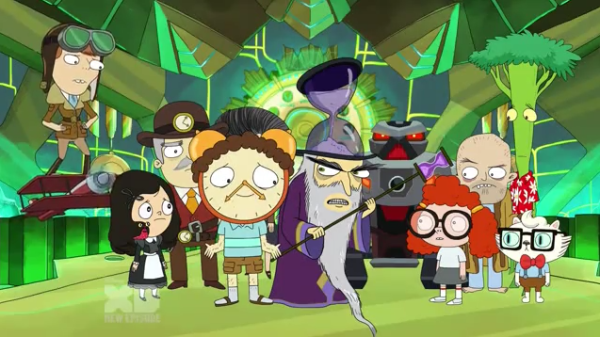
Stories are funny that way. So is time. So are the way we tell and consume stories these days. Future-Worm knows this, and uses it to its advantage.

